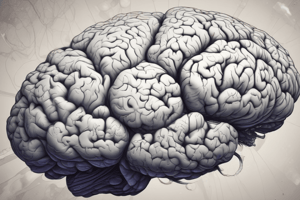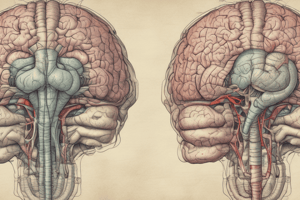Podcast
Questions and Answers
What is the role of the autonomic nervous system?
What is the role of the autonomic nervous system?
- Controls voluntary actions
- Maintains involuntary activities (correct)
- Processes sensory information
- Regulates emotions
Which part of the brain is responsible for thinking?
Which part of the brain is responsible for thinking?
- Thalamus
- Cerebrum (correct)
- Brainstem
- Cerebellum
Which disorder is characterized by symptoms of inattention, hyperactivity, and impulsivity?
Which disorder is characterized by symptoms of inattention, hyperactivity, and impulsivity?
- Alzheimer's Disease
- ADHD (correct)
- Tourette Syndrome
- Dyslexia
What condition is caused by a progressive disorder affecting nervous system function?
What condition is caused by a progressive disorder affecting nervous system function?
Which risk factor is associated with Alzheimer's Disease?
Which risk factor is associated with Alzheimer's Disease?
Which of the following is a neurological disorder characterized by tics?
Which of the following is a neurological disorder characterized by tics?
What is meningitis?
What is meningitis?
Which condition describes general impaired cognitive function affecting daily activities?
Which condition describes general impaired cognitive function affecting daily activities?
What is the primary function of the occipital lobe?
What is the primary function of the occipital lobe?
Which part of the nervous system is responsible for involuntary actions?
Which part of the nervous system is responsible for involuntary actions?
What role do dendrites play in neuron function?
What role do dendrites play in neuron function?
Which type of neuron transmits signals from sensory organs to the brain?
Which type of neuron transmits signals from sensory organs to the brain?
Which function is NOT associated with the brain stem?
Which function is NOT associated with the brain stem?
What is the role of myelin sheaths in neurons?
What is the role of myelin sheaths in neurons?
Which division of the nervous system controls voluntary activities?
Which division of the nervous system controls voluntary activities?
The main function of interneurons is to:
The main function of interneurons is to:
Study Notes
Functions of the Cerebrum
- The cerebrum has distinct lobes with specific functions:
- Occipital lobe processes vision.
- Frontal lobe is responsible for cognitive functions and controlling voluntary movements.
- Parietal lobe manages temperature, taste, touch, and movement sensations.
- Temporal lobe integrates and processes memories alongside different sensory experiences.
Anatomy of a Neuron
- Neurons consist of:
- Dendrites that receive information toward the cell body.
- Axons that send messages away from the cell body.
- A cell body that contains the nucleus.
- Synapse acts as a relay point for nerve impulse transmission.
- Myelin sheath covers axons to speed up impulse transmission.
Types of Neurons
- Sensory neurons transmit signals from sense organs to the brain.
- Motor neurons send signals from the brain and spinal cord to muscles and glands.
- Interneurons process sensory information and regulate motor activity.
Neural Processing
- Nerve impulses travel from dendrites to axons, using neurotransmitters to cross synapses.
Peripheral Nervous System (PNS)
- Divided into sensory and motor nerves:
- Sensory nerves carry signals related to the five senses to the brain.
- Motor nerves transmit signals to muscles and glands.
Central Nervous System (CNS)
- Comprises the brain, encased in the skull, and the spinal cord, which transmits nerve signals between the brain and body.
- The brain is the central processing unit for the nervous system.
Brain Stem
- Connects spinal cord to the brain, regulating survival functions.
- Contains three regions:
- Medulla Oblongata controls involuntary actions.
- Midbrain processes visual and auditory reflexes.
- Pons aids in respiratory function.
Divisions of the Nervous System
- Somatic nervous system controls voluntary activities.
- Autonomic nervous system manages involuntary activities (e.g., heart rate), further classified into:
- Parasympathetic system maintains homeostasis and restful functions.
- Sympathetic system prepares the body for "fight or flight."
Diseases and Disorders of the Nervous System
-
ADHD (Attention Deficit Hyperactivity Disorder):
- Symptoms include inattention, hyperactivity, and impulsivity.
- Affects about 10% of school-aged children.
-
Alzheimer’s Disease:
- A neurodegenerative disease, major cause of dementia.
- Risk factors include age, genetics, and lifestyle choices.
-
Dyslexia:
- Learning difficulty that affects reading and spelling.
- Risk factors include genetics and brain processing differences.
-
Aneurysm:
- A bulge in an artery in the brain.
-
Parkinson’s Disease:
- A progressive disorder that affects nervous system function.
- Risk factors encompass age, genetics, and exposure to toxins.
-
Multiple Sclerosis (MS):
- An autoimmune disease affecting the CNS with risk factors including family history and geographic location.
-
Tourette Syndrome (TS):
- Neurological disorder characterized by tics.
- Risk factors include family history and prenatal factors.
-
Meningitis:
- Infection and inflammation of the brain and spinal cord's protective membranes.
- Risk factors include skipping vaccinations and a weakened immune system.
-
Dementia:
- General term for cognitive impairment affecting daily activities.
Studying That Suits You
Use AI to generate personalized quizzes and flashcards to suit your learning preferences.
Related Documents
Description
Explore the functions of the cerebrum, including how different lobes like the occipital, frontal, parietal, and temporal contribute to vision, cognitive functions, and sensory experiences. This quiz covers the anatomy of neurons and their roles in the nervous system, focusing on communication within the brain. Test your understanding of these fundamental concepts in neuroscience.




